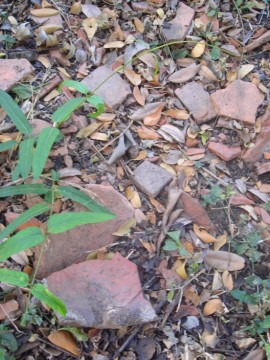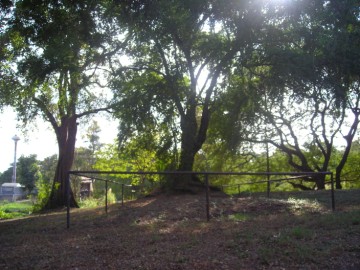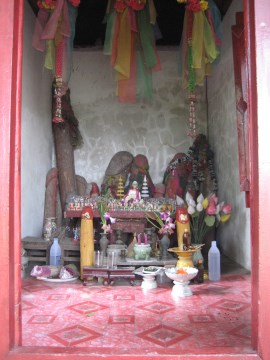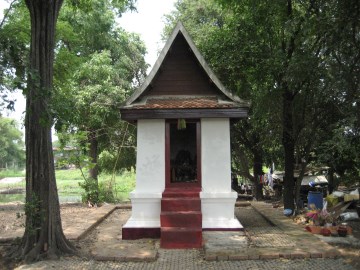| OLD KILN |
| An ancient kiln and an accompanying Brahman shrine can bee seen at the same location beside Khlong Hua Ro (the old Lopburi River). They are situated north of the main island on the Phaniat peninsula. The elephant kraal is directly to the east. The collapsed ruin of a single kiln is still viewable. There is plenty of broken ceramic pieces and roof tiles scattered nearby. The ceramics are mostly for functional purposes in the unpainted local style. A Ficus Religiosa or Bodhi tree grows over this site, which has been squared off by metal posts and layered with a brick foundation. It is not clear as to when the kiln was built, or when it was last used, but its location provided access to water for processing the ceramics and enabled easy transport of the finished product by boat. A second feature at this site is a small Brahman shrine. At the staircase there is a collection of elephant bones. Inside the shrine there are dozens of phallic images (lingam), reflecting the style of wooden posts used at the elephant kraal. These have been careful wrapped with decorative cloth. The phallic images at the shrine suggest a Brahman influence, and these priests were involved with several ceremonies concerning elephants, including ceremonies for replacing the wooden posts. It is one of two shrines in the area (the second was built in recent times on the northwestern corner of the elephant kraal). The date of the Brahman shrine is unclear, but it could have been built on an older site. According to the Fine Arts department, a group of Brahman priests lived on the opposite side of Khlong Hua Ro, in the vicinity of where Wat Phrao was once located. A market in this area sold incense, perfume, and scented powder. It is reasonable to believe that they crossed the river and used this site for ceremonies involving the elephant kraal. The kiln and Brahman shrine have both been renovated recently. Mahouts from the elephant kraal still visit the Brahman shrine sometimes. |

| Text & Pictures by Ken May - April 2009 |


| (View of the old kiln site) |
| (Fragmented tiles in situ) |
| Addendum The shrine at the old kiln site is a sacred fertility shrine since olden days, taken into account the explicit collection of phallic carvings, symbolizing a combination of the male and female organs. Brahmin theory relates the spirit that resides in the Linga symbol to the God Shiva. [1] Women seeking pregnancy have long visited fertility shrines for divine help in conception. Salvatore Besso on his visit to the kraal in 1911 wrote: "From the governor's palace we visited the enclosure where the elephants breed ; very lonely and picturesque, but, alas without elephants. Close by is a small temple of Fecondity, somewhat suggestive. Here the women come to pray to Buddah for children." [1] References: [1] Bendix, Reinhard. Max Weber: An Intellectual Portrait. University of California Press (1977) - page 186. [2] Besso, Salvatore. Siam and China. London: Simpkin, Marshall, Hamilton, Kent & Co. LTD (1913) - page 51. |
| Addendum by Tricky Vandenberg - August 2014 |


| (The fertility shrine on the old kiln site) |
| (Inside view of the fertility shrine) |
